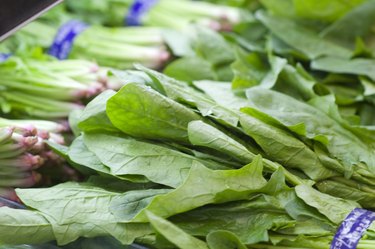
Spinach leaves contain multiple pigments. Among these are chlorophyll a and chlorophyll b, beta-carotene and xanthophylls, all of which are photosynthetic pigments, meaning they can absorb light as part of photosynthesis. You might have wondered why spinach plants can't just manage with a single pigment and thereby save themselves the trouble of making more. As it happens, however, each pigment has certain advantages that ultimately mean they work better together.
Wavelengths
Video of the Day
Each pigment only absorbs certain wavelengths of light -- that's why they have different colors. Chlorophylls, for example, reflect most of the green light that strikes them, so the spinach leaves have a green color. While pretty, this feature is also a disadvantage in some ways because the spinach can't make use of the green light for photosynthesis if it uses only chlorophyll. White light and sunlight are a mixture of many different wavelengths, so the spinach would ideally like to make use of as many of these as possible.
Video of the Day
Absorption
If you plotted the fraction of light energy absorbed as a function of the wavelength of the light, you'd have a graph with peaks to mark wavelengths where each pigment absorbs light very efficiently and troughs to show where they don't absorb it at all. From this graph, you would see that chlorophyll a and b absorb very well in the blue and red regions of the spectrum, but not in between. That's where the other spinach pigments come in. These secondary pigments are sometimes called accessory pigments.
Accessory Pigments
The accessory pigments in the spinach help to cover regions of the spectrum where chlorophylls offer insufficient absorption. Beta-carotene, for example, is an orange-colored pigment that absorbs well at wavelengths between 460 and 550 nanometers, slightly below the peak for chlorphyll b. Other carotenoids such as lutein absorb in a similar region of thte spectrum. Xanthophylls are yellow in color and absorb well in the 400 to 530 nm region, thereby extending the range of wavelengths the plant can use effectively.
Considerations
Despite these accessory pigments, spinach still can't use most of the light in the green-yellow region of the spectrum, which is why spinach leaves have a lovely dark green color. The same is true of most other plants. Some algae and cyanobacteria have accessory pigments that effectively absorb light in the green-yellow region of the spectrum like phycobilins; spinach and most other plants, however, lack this convenience.